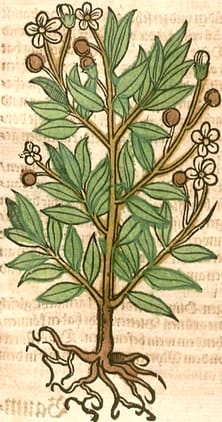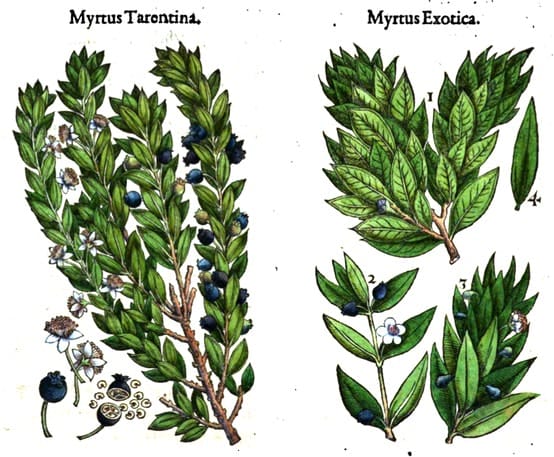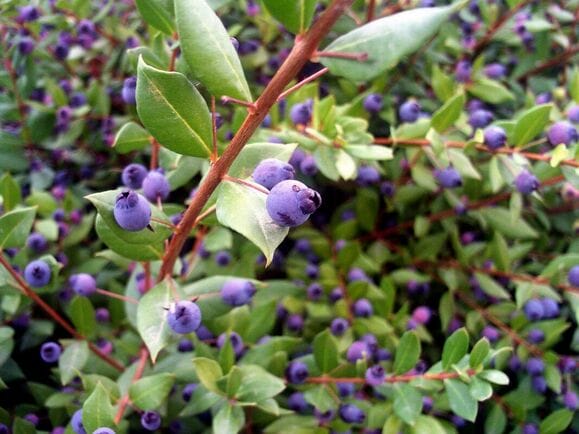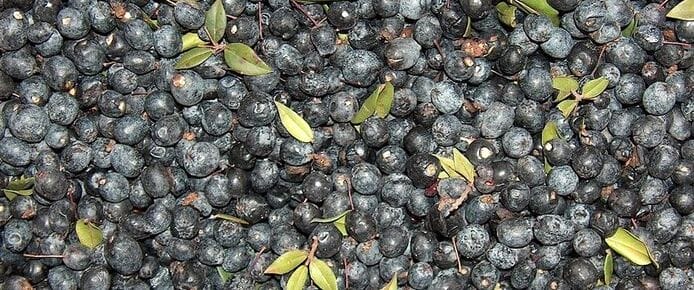Myrtus, Myrtle
Myrtle, Clove Myrtle, Spanish MyrtleHabb-ul-Ass, Muurad (Unani)
 Krauterbuch, Lonitzer, 1578
Krauterbuch, Lonitzer, 1578 Two varieties of Myrtus
Two varieties of MyrtusKreutterbuch, Matthiolus, 1586
 Myrtus communis
Myrtus communis(Photo by Javier martin) (Wikimedia)
 Myrtle berries
Myrtle berries(Photo by Giancarlo Dessì) (Wikimedia)
 Members CLICK HERE for the PRO VERSION
Members CLICK HERE for the PRO VERSIONBotanical name:
Myrtus communis
Parts used:
Leaves, Fruit (‘berries’), Seed
Leaf is more commonly used internally, berries mostly externally
“Small shoots of its roots are most potent”. (Avicenna)
Temperature & Taste:
Cool, dry. Bitter
“It has some mild hotness though coldness is dominant” (Avicenna)
Classifications:
2N. REPELLENT
3D. CORDIALS & CARDIACS
4a. CEPHALIC. 4c. CARDIAC. 4e. STOMACHIC. 4k. ARTHRITIC
Uses:
1. Stops Leakage, Retains Essence: (mostly Leaf, fruit)
-Diarrhea, Dysentery, Spermatorrhea and Leukorrhea. (leaf, fruit)
2. Clears Heat and Damp, promote Urine:
–Edema
3. Clears Heat, Stops Cough: (Berries in Syrup)
-Cough, Respiratory
4. Clears Phlegm, Resolves Masses: (leaf)
-Scrofula
5. Benefits the Heart:
6. Resists Poison:
7. Kills Worms:
9. Externally:
-Eczema, flaky skin conditions including Dandruff, Morphew (fruit decoction as a wash)
Dose:
Myrtle Berries: 3–5 grams
Preparation:
Sometimes Myrtle berries or seed were roasted or torrefied for use. This makes them more astringent and less irritating, and was used for Diabetes and Incontinence in particular.
Correctives:
… available in PRO version
Substitutes:
… available in PRO version

Main Combinations:
1. Hemoptysis, Myrtle with … available in PRO version
2. Chronic Diarrhea:
i. Myrtle with … available in PRO version
ii. Myrtle berry … available in PRO version
iii. Myrtle berry, … available in PRO version
iv. Myrtle with … available in PRO version
3. Diabetes: Myrtle seed with … available in PRO version
4. Incontinence: Myrtle berry torrefied with … available in PRO version
5. Infertility, Myrtle berry with … available in PRO version
Major Formulas
Powder for Diabetes (Unani)
Powder for Chronic Diarrhea (Nicholas)
Troches of Ramich (Mesue)
Pills Against Fluxes (Nicolas)
Electuary for Incontinence (Riverius)
Electuary Against Sterility (Renodeus)
Restorative of Nicholas (Pleres Arconticon) (Nicholas)
Cautions:
None noted
Main Preparations used:
Syrup of Myrtles, Infused Oil of Myrtle Leaves
- Extra Info
-
History
|
‘Amongst the ancients the Myrtle was a phallic emblem sacred to Venus, at the festival of Myrrha, the incestuous mother of Adonis, married women wore wreaths of the leaves; and in Virgil’s infernal regions the victims of love concealed themselves among the myrtles. At Rome this plant was not allowed to be placed upon the altar of Bona Dea, but at the festivals of Eleusis every one was crowned with it; it was supposed not only to inspire love, but to maintain it. According to a Greek myth, the nymph Myrsine, having outstripped Athene in a race, was turned into a myrtle bush by the goddess, who, however, repenting of her cruelty afterwards, became particularly attached to the plant. The Romans, after they had intended fighting for the Sabine women whom they had carried off, purified themselves with sprigs of myrtle, idce tunc lecta (says Pliny) quoneam conjuctioni et huic arbori prceest Venus. Pliny also tells us that Romulus planted two myrtles at Rome, one of which afterwards became the favourite of the patricians, and the other of the people; when the former had the upper hand the plebeian myrtle withered, but when the power of the latter was in the ascendant the patrician myrtle faded. Before pepper was known myrtle berries were employed as a spice to season food, and wine was flavoured with them. For many other superstitions concerning the myrtle extending down to modern times, see De Gabernatis (Myth, des Plantes, II., 233). The myrtle occupies a prominent place in the writings of Hippocrates, Pliny, Dioscorides, Galen, and the Arabian writers. Pliny furnishes an account of it, of which the following is a summary: The berries arrest haemoptoe; they are used in dysentery and as an application to indolent ulcers and inflamed eyes; and in wine are an antidote to the poison of mushrooms; they also cure the bites of scorpions, inflammation of the bladder, headaches, abscesses, aphthae, leucorrhcea, and other mucous discharges. The juice is diuretic, but constipates. An ointment made with it cures eruptions of the skin and darkens the hair. The dried leaves in powder arrest sweats; in fomentations check the white flux, correct prolapsus of the womb and rectum, and are employed to cure ulcers, burns, |
erysipelas, otorrhoea, alopecia, and eruptions of the skin, to arrest haemorrhage, and as an application to lentigo, pterygion, panaris, condylomata, and swelled testicles. A wine made from the berries was used for most of these purposes, and was regarded as tonic. This catalogue of virtues is repeated, but hardly enlarged, by subsequent ancient writers, who, however, following Galen, ascribe to myrtle the opposite qualities of cold and hot, or astringent and stimulant, the former residing chiefly in the leaves, the latter in the berries. In 1876 attention was directed to the medicinal properties of the plant by Delioux de Savignac, who recommended an infusion or diluted tincture of the leaves as an astringent lotion, and the finely powdered leaves as an application to ulcers, &c. He also used the powder in doses of 1 to 4 grams internally in chronic catarrh of the bladder and in menorrhagia; and the infusion in chronic bronchitis. The Oxymyrsine or “wild myrtle,” mentioned by the ancients, the Aas-el-bari of Mahometan writers, is not a myrtle, but the Ruscua aculeatus or ” butcher’s broom.” Of late years the volatile oil of myrtle leaves has been brought to notice as an antiseptic and rubefacient when used externally; given internally, in small doses (0.06 to 0.09 gram), it promotes digestion like myrtle berries, but in large doses it acts as an irritant. It is excreted by the kidneys and through the respiratory tracts, and communicates a peculiar odour to the urine. According to Lauder Brunton the urine of persons taking it gives a precipitate with nitric acid; he considers that like copaiba it may be used as an expectorant in chronic bronchitis with profuse expectoration and in chronic inflammation of the bladder or urethra. It is best administered in gelatine capsules containing 4 to 5 drops of the oil. The fragrant water distilled from the flowers and leaves is known in France as Eaud’ange. According to Brannt, the manufacturers of volatile oils in Southern France place a myrtle water upon the market which is actually prepared from the oil.’ (Pharmacographia Indica, Dymock, 1891) |
